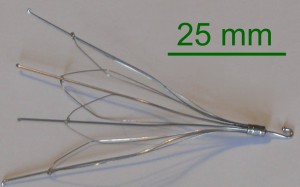IVC Filter No Improvement in Survival After Trauma: Study
 For over a decade, the use of IVC filters to prevent deep vein thrombosis has been controversial. Now a new study backs up some of the critics, concluding that implanting an inferior vena cava filter does not improve a trauma patient’s chances of survival and may actually contribute to additional blood clotting.
For over a decade, the use of IVC filters to prevent deep vein thrombosis has been controversial. Now a new study backs up some of the critics, concluding that implanting an inferior vena cava filter does not improve a trauma patient’s chances of survival and may actually contribute to additional blood clotting.
Study finds no benefit to IVC filter after trauma
Researchers from the University of Michigan published the study last month, in the journal Annals of Surgery, indicating that trauma patients who received an IVC filter did not survive any longer than patients who did not receive the device. The study looked at five years’ worth of data, spanning 2010-2014.
Reviewing five years’ data spanning 2010 to 2014, the researchers divided hospitals into groups based on the percentage of patients who received the IVC filter. Out of 39,456 patients, 2%, or 803, received the filter. Some hospitals used it rarely (.6% of trauma patients) and some, often (9.6% of trauma patients).
Comparing hospitals within groups based on the incidence that they implanted IVC filter, they found no improvement in mortality rates linked to the device. There was, however, an increase in DVT (deep vein thrombosis – blood clots in the deep veins, usually the legs).
Repeated blood clots can be deadly
Patients who undergo surgery or other trauma are at risk of developing blood clots in the deep veins, especially in the legs. The clots can break free and travel to the lungs and block one of the pulmonary arteries, a condition known as a pulmonary embolism (PE). Nearly 30% of patients who experience an untreated PE do not survive. Those who suffer repeated blood clots are at the greatest risk of death.
The standard treatment for recurring blood clots is anticoagulation medications. But anticoagulants are not always effective or recommended for many patients and in those cases, an IVC filter may be placed.
About the IVC filter
Doctors have been trying to prevent PEs by modifying the IVC for over 150 years; in 1868, it was first proposed to surgically close off the vein to keep clots from traveling to the lungs. Nearly a century later, in 1967, the first IVC filter entered the market.
The IVC filter is a small metal basket that looks like a spider. Blood clots get trapped in the legs of the filter. Ideally, the clot will then be broken down by the body.
Few “retrievable” IVC filters are actually retrieved
IVC filters typically look like small metal spiders. They work by catching blood clots, also called thrombi, in the cage area that is formed where the metal legs are joined so that they cannot reach the heart or lungs.
The first IVC filters were designed to stay in place permanently and a few, including Bard’s G2 Filter, OptEase by Cordis, and Gunther Tulip and Celect filters by Cook Medical, are removable filters that were designed to be retrieved once the threat of blood clots has passed. But more often than not, the retrievable filters are not removed and the longer they stay in place, the greater the risk of IVC filter complications.
When an IVC filter is left in place, dangers include migration of the device and perforation, injuries from parts of a broken filter, and breathing and circulation problems from malfunctions.
In 2014, the FDA updated safety communications recommending that doctors work with their patients to remove retrievable filters as soon as possible, ideally between the 29 and 54 day after implant.
- Annals of Surgery, Abstract: Prophylactic Inferior Vena Cava Filter Placement Does Not Result in a Survival Benefit for Trauma Patients, http://journals.lww.com/annalsofsurgery/Abstract/2015/10000/Prophylactic_Inferior_Vena_Cava_Filter_Placement.4.aspx
- Mayo Clinic, Deep Vein Thrombosis (DVT), http://www.mayoclinic.org/diseases-conditions/deep-vein-thrombosis/basics/definition/con-20031922
- Medscape, FDA Warns of Adverse Events With Inferior Vena Cava Filters, http://www.medscape.com/viewarticle/726711
- Medscape, Safety and Effectiveness of Inferior Vena Cava Filters Used to Protect Against Pulmonary Embolus: A Technology Assessment, http://www.medscape.com/viewarticle/744331_2
- FDA, Removing Retrievable Inferior Vena Cava Filters: FDA Safety Communications, http://www.fda.gov/MedicalDevices/Safety/AlertsandNotices/ucm396377.htm


 Resources
Resources
 Resources
Resources